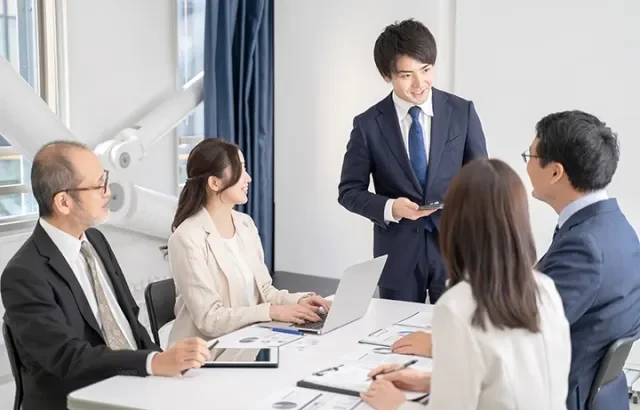【 with example sentences 】 What does "よろしくお願いします (yoroshiku onegaishimasu)" mean? Honorifics and English expressions.

よろしくお願いします (yoroshiku onegaishimasu)" is one of the most important phrases in learning Japanese. It is frequently used in Japanese daily conversation and you will hear it in various situations. However, surprisingly few people may understand the meaning, usage, and English expressions of "よろしくお願いします" in detail.
Especially for learners of Japanese, they may find it difficult to grasp the nuances of "よろしくお願いします". Many of them may also want to know about the appropriate usage in business situations and keigo expressions.
In this article, we will therefore explain in detail the meaning and usage of "よろしくお願いします," English expressions, and honorific expressions, with example sentences.
▼Goandup Picks Click here for recommended articles!
- Required before studying abroad! Goandup Nihongo+, an online Japanese language learning service
- This page introduces services for foreigners who wish to study in Japan or improve their Japanese language skills to learn Japanese online.
- Goandup Salon" community for foreigners living in Japan
- We introduce an online community where foreigners living in Japan can exchange information and interact with each other to support their life in Japan.
- Goandup Study" supports foreigners who want to study in Japan.
- This section introduces study abroad support services that provide comprehensive support to foreigners who wish to study in Japan, from preparation for study abroad to living in Japan.
- Where can I buy a prepaid SIM in Japan? Recommended SIM cards for foreigners are also introduced.
- How to purchase a prepaid SIM and suitable SIM cards for foreigners.
- The Complete Guide to Pocket Wi-Fi in Japan for Foreigners!
- We introduce how to select and recommend pocket Wi-Fi products that can be used conveniently in Japan.
- The Complete Guide to Finding a Job in Japan! Finding a job, changing jobs, and part-time work for foreigners
- This site provides foreigners who want to work in Japan with comprehensive information on how to find a job, recommended job sites, and other information necessary to find a job.
What does よろしくお願いします (yorosiku onegaisimasu) mean?

よろしくお願いします" is a unique Japanese expression and a useful phrase used in many situations. However, looking around at other languages in the world, there are few versatile phrases like "よろしくお願いします" that can be used in a variety of situations with a single expression.
For example, in English, Chinese, and Korean, it is necessary to use appropriate expressions depending on the situation. It is difficult to express the equivalent of "よろしくお願いします" in a single word, so it must be phrased differently depending on the situation.
In Japanese, on the other hand, a single word "よろしくお願いします" can cover a wide range of situations, from initial greetings to requests. One reason for this may be that Japanese is a language that reflects a high context culture.
High-context culture is a culture that emphasizes background, context, and nonverbal communication as well as words. Perhaps it is because of this cultural background that the Japanese language has developed expressions that can convey so much in a single word.
To be active in a global society, it is essential to understand not only the language but also the cultural background. Learning unique Japanese expressions such as "よろしくお願いします" is very important to deepen your understanding of Japanese culture and to facilitate smooth communication.
English expressions for 【 situations 】よろしくお願いします (yorosiku onegaisimasu)

When expressing "よろしくお願いします" in English, it is necessary to choose appropriate words depending on the situation and the relationship with the other party. Here we will discuss six typical situations and introduce English phrases that can be used in each situation.
Greetings to new acquaintances "Nice to meet you, nice to meet you."
The "よろしくお願いします" used in initial greetings expresses goodwill and respect for the other party.
In English, expressions such as "Nice to meet you." or "It's a pleasure to meet you. You can also express a positive attitude toward the future of the relationship by saying, "I'm looking forward to working with you.
2. Words to use when parting: "I look forward to working with you in the future."
Used in parting, "we will continue to よろしくお願いします" expresses the desire for an ongoing relationship.
In English, phrases such as "Please keep in touch." or "Let's stay in contact." are often used. In business situations, "I look forward to our continued partnership.
3. "Please take care of it for me," when asking for a favor.
When asking for something, "よろしくお願いします" has a strong connotation of asking for the other party's cooperation.
In English, expressions of gratitude such as "Thank you for your help." or "I appreciate your assistance." are key. It is also important to make the request politely, for example, "I would be grateful if you could...".
Please take care of me" used to close an email.
The "よろしくお願いします" often found at the end of business emails serves to emphasize the politeness of the overall message.
In English e-mails, standard phrases such as "Best regards," "Sincerely," etc. are used. For a more formal impression, you may want to end with "I appreciate your attention to this matter.
Good day to you" used for meetings and contracts.
The phrase "よろしくお願いします today," used at the beginning of a meeting or business discussion, shows the sincerity with which you approach the situation.
In English, you can express your appreciation for their time by saying "Thank you for taking the time to meet with me today." or "I appreciate you making time for this meeting . ." In English, it is best to thank the person for taking the time to meet with you, such as "Thank you for taking the time to meet with me today.
6. New Year's greeting: "I look forward to working with you this year.
In New Year's greetings, "Another よろしくお願いします this year" is often used.
The standard phrase in English is "Happy New Year!" but in business situations, you can make a good impression by using phrases such as "I look forward to working with you again this year . ." or "Here's to another successful year together." In a business situation, it is a good idea to express your desire for an ongoing relationship on the occasion of the New Year.
What is "よろしくお願いします" in languages other than English?
Thus, we have looked at "よろしくお願いします" English expressions for six different situations. It is essential for smooth communication not only to change the words, but also to understand the feelings that are put into them.
Languages other than English also have their own culturally specific ways of expressing themselves. For example, the Chinese phrase "请多关照 (qǐng duō guānzhào)" and the Korean phrase "잘 부탁드립니다 (jal butak deurimnida)" are similar in meaning to "よろしくお願いします" The phrase has a similar meaning to "よろしくお願いします".
Exposure to multiple languages is a good opportunity to learn about the diversity of languages. At the same time, you will realize the importance of understanding the differences in culture and values behind languages.
How to use よろしくお願いします (yorosiku onegaisimasu) and example sentences

Here we will show you example sentences in which "よろしくお願いします" is used in actual conversation in three different situations. By learning how to use it appropriately, you will be able to improve your ability to communicate in Japanese.
1. greeting new acquaintances
In first meeting greetings, "Nice to meet you" and "よろしくお願いします" are often used as a set. Let's use the following example sentences in actual conversation.
【 Example 】
| Yamada: Nice to meet you, I am Yamada. I will be working with you in the tennis circle from today. よろしくお願いします. John: Nice to meet you, I'm John. It's nice to meet you too, よろしくお願いします. I hope we can enjoy playing tennis together. |
Thus, when someone says "よろしくお願いします," it is common to reply, "It is my pleasure, よろしくお願いします. This kind of exchange, even with someone you have never met before, will help you build a good relationship.
2. parting greetings
In parting greetings, the expression "I look forward to seeing you again in the future よろしくお願いします" is often used. Please refer to the following example sentences and try to use them in actual conversation.
【 Example 】
| Sato: It was a fun drinking party today. Please join us again next time. よろしくお願いします in the future as well. Mary: My pleasure, よろしくお願いします. let's make another opportunity to get together like this. |
The parting "よろしくお願いします" expresses the desire to establish an ongoing relationship. In response to a "よろしくお願いします" from the other party, you can convey that you feel the same way by replying, "It's nice to meet you, too.
3. when asking for a favor
Used when asking for something, "よろしくお願いします" has the connotation of asking for the other party's cooperation. Refer to the examples below to use it in appropriate situations.
【 Example 】
| Harry: Mr. Sato, can you help me move this coming Sunday? I have a lot of stuff and it's hard for me to do it alone. Sato: Of course, that's fine. I will help you. Harry: Thank you, よろしくお願いします. |
Thus, when a request is accepted, it is important to first show your gratitude to the other party by saying "Thank you. Then, by adding "よろしくお願いします," you can again express your polite request.
These are some examples of how to use "よろしくお願いします" in three different situations, along with example sentences. By being able to use it appropriately in conversation, smooth communication will become possible.
How to use the 【 honorific 】よろしくお願いします (yorosiku onegaisimasu) with a superior

When communicating with superiors in business situations, you are expected to use honorific expressions. Here we introduce two honorific expressions for "よろしくお願いします".
1. "Please take care of me. (yoroshiku onegai itashimasu"
Please give me your best regards" is a respectful version of "よろしくお願いします". When used with superiors, it gives a more polite and courteous impression.
【 Example 】
| Tanaka: Director Suzuki, thank you very much for your valuable time today. I look forward to your continued guidance and encouragement. General Manager Suzuki: Mr. Tanaka, it is my pleasure to meet you. Let's achieve great results together. |
When conversing with your superiors, try to use "I am looking forward to working with you" instead of "よろしくお願いします". It conveys respect for the other person and helps build a good relationship.
2. "Please give me your best regards. (yoroshiku onegai moushiagemasu)"
Please accept my best regards" is an even more polite expression than "I would like to thank you for your kind attention. It is mainly used in written language such as e-mails and letters.
【 Example 】
| Subject: 【 Greetings 】 New Product Development Thank you very much for your continued support. Thank you very much for your recent suggestion regarding the development of a new product. Further details will be provided as they become available. We look forward to your continued guidance and encouragement. |
Thus, "Best regards" is often used as a concluding phrase in business e-mails. It is an expression that politely conveys gratitude to the recipient and expectations for an ongoing relationship.
Mastering the use of keigo may be one of the most difficult tasks for Japanese language learners. However, proper use of keigo also provides a good opportunity to deepen one's understanding of Japanese culture and Japanese business customs.
Serious employment support to help you realize your dream of working in Japan!

Do you want to work in Japan?
Let us "Goandup" make that dream a reality!
【 Program Features 】
✅ JLPT N3 level Japanese language acquisition
✅ Thorough preparation for the specific skills test
✅ Full support for job hunting in Japan
Business-focused one-on-one lessons will help you find a job in Japan in the shortest possible time.
【 Program Menu 】
- Individual Japanese language lessons
- Intensive curriculum to obtain N3, especially specialized lessons for business Japanese that can be used at work.
- Intensive curriculum to obtain N3, especially specialized lessons for business Japanese that can be used at work.
- Preparation for the Specific Skills Test
- Customized materials for specific skill tests will be used to focus on frequently asked questions and learning to pass the test.
- Customized materials for specific skill tests will be used to focus on frequently asked questions and learning to pass the test.
- Resume and CV support
- To create resumes and CVs tailored to Japanese corporate culture, and to brush up on self-promotion and motivation for application.
- To create resumes and CVs tailored to Japanese corporate culture, and to brush up on self-promotion and motivation for application.
- Interview Preparation
- Guidance on areas for improvement through mock interviews and feedback based on corporate interview scenarios. Learn interview etiquette and behavior unique to Japan.
- Guidance on areas for improvement through mock interviews and feedback based on corporate interview scenarios. Learn interview etiquette and behavior unique to Japan.
- career consulting
- Provide introductions to companies that match the participant's career goals, select companies to apply to, and provide advice on the level of knowledge required by the companies to which the participant is applying.
- Provide introductions to companies that match the participant's career goals, select companies to apply to, and provide advice on the level of knowledge required by the companies to which the participant is applying.
- Chat Support
- In addition to one-on-one individual lessons, we also accept casual questions via DM (visa application, living support, assistance in finding a room, etc.).
If you are serious about your career in Japan, join us now!
▶︎ for more informationclick here.
We will do our best to support your success in Japan!
summary
In this article, we have explained the Japanese term "よろしくお願いします" in detail, including its meaning, usage, English expressions, and honorific expressions.
よろしくお願いします" is a very frequently used phrase in Japanese. We hope you have found it to be a useful expression that can be used in a variety of situations, from greeting someone at the first meeting to parting greetings.
We explained that other languages, including English, have few universal expressions like "よろしくお願いします" that can be used in a wide variety of situations. One reason for this may be that Japanese is a language that reflects a high context culture.
Understanding the meaning and usage of "よろしくお願いします" will not only help you learn Japanese, but also deepen your understanding of Japanese culture and Japanese business customs. Understanding the cultural nuances behind the words is essential for effective communication.
We hope this article will help readers learn Japanese and understand Japanese culture.
Your support will help us!
Thank you for visiting Goandup Picks. Our mission is to provide you with more useful information to show the world what Japan has to offer.
Your support will help us to further enhance our activities, so please support us!






